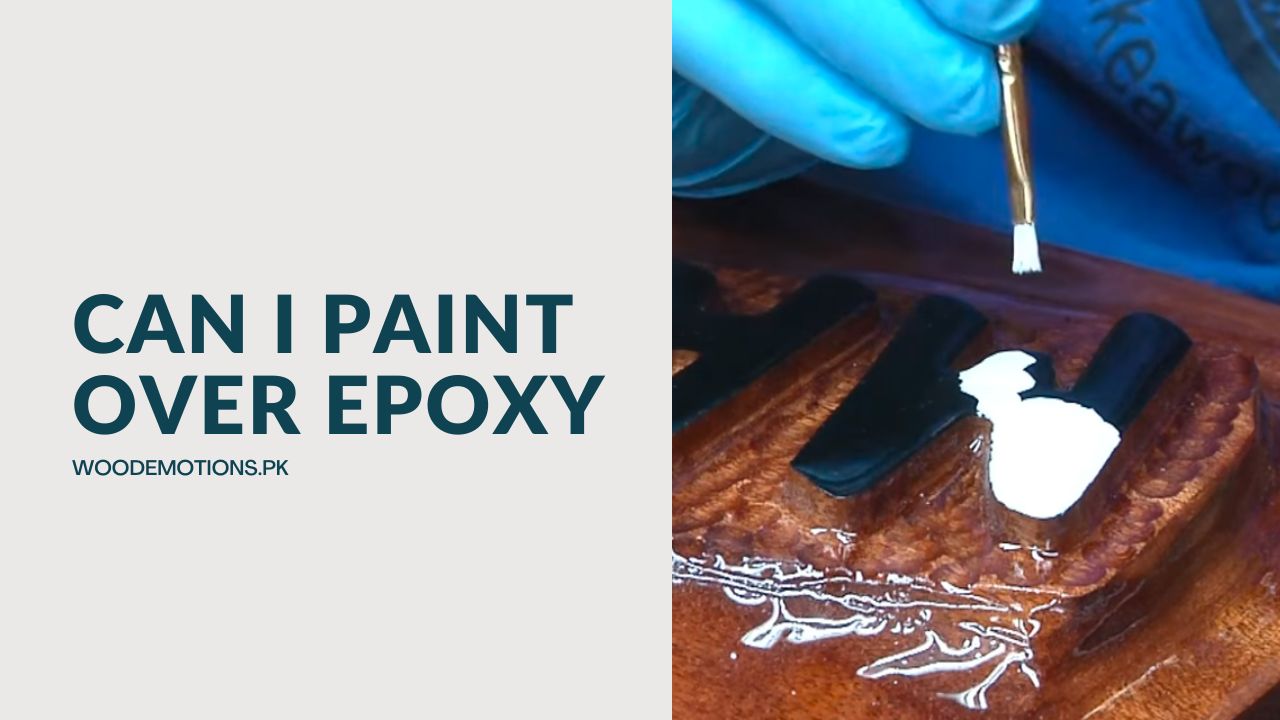Epoxy coatings are known for their durability and resilience, making them a popular choice for various surfaces, from garage floors to countertops. But what if you want to change the color or update the look of your epoxy-coated surface? Can you simply paint over it?
Yes, once the epoxy resin has fully cured, you can prepare the surface according to the paint manufacturer's directions to apply decorative paint or artist colors.
In this guide, we'll delve into the intricacies of painting over epoxy, exploring the process, considerations, and tips for achieving optimal results.
Can I Paint Over Epoxy
Yes, you can paint over epoxy, but before you start grabbing paintbrushes, there are a few things you need to think about to ensure you get the best results possible.

Factors to Consider
- Condition of the Epoxy
First things first, take a good look at the epoxy coating you want to paint over. If it's in good shape with no peeling or damage, you're good to go. However, if it's showing signs of wear and tear, you might need to do extra prep work to ensure the paint adheres properly.
- Type of Paint
Not all paints are created equal, especially when it comes to painting over epoxy. Make sure you choose a paint that's specifically designed for use on epoxy surfaces. Using the right paint will help ensure good adhesion and a long-lasting finish.
- Desired Outcome
Think about what you want the finished result to look like. Are you just looking to change the color of the epoxy, or do you want to completely cover it up? The answer to this question will help you determine the best approach and the type of paint to use.
- Preparation
Proper preparation is key to a successful paint job. Make sure the epoxy surface is clean and free of any dirt, dust, or grease. You may also need to sand the surface lightly to help the paint adhere better.
Read our Detailed guide on Epoxy resin, uses, types
- Time and Patience
Painting over epoxy is a process that takes time, so make sure you have enough time set aside to do the job correctly. Rushing through it will only result in a poor finish that won't last.
Are you looking for epoxy? Check out our Genc Epoxy , offering a variety of options to cater to your specific needs and preferences.
Adding a Quora link for further information. This source might provide additional insights and experiences related to painting over epoxy coatings.
Steps to Paint Over Epoxy
So, you've decided to give your epoxy-coated surface a fresh look with a coat of paint. Here's a step-by-step guide to help you achieve a smooth and successful paint job:
1. Surface Inspection
Before you begin painting, take some time to inspect the epoxy coating. Look for any signs of damage, such as peeling, chipping, or discoloration. If the epoxy is in poor condition, it may need to be repaired or replaced before painting can proceed. In case you see any dimples in your epoxy project this guide will help you to fix it "fix epoxy dimples".
2. Surface Preparation
Proper preparation is key to ensuring that the new paint adheres well to the epoxy surface. Start by thoroughly cleaning the surface with a degreaser to remove any dirt, oil, or contaminants. Rinse the surface with clean water and allow it to dry completely.
3. Sanding
Next, lightly sand the epoxy surface to create a rough texture to help the paint adhere better. Use fine-grit sandpaper and sand in a circular motion until the surface feels slightly rough to the touch. Be sure to remove any dust or debris left behind from sanding.
4. Priming
Applying a primer specifically designed for use on epoxy surfaces is essential for promoting adhesion and ensuring a long-lasting finish. Choose a high-quality primer compatible with epoxy and the type of paint you plan to use. Apply the primer evenly to the entire surface and allow it to dry thoroughly according to the manufacturer's instructions.
5. Paint Application
Once the primer has dried, it's time to apply the paint. Use a high-quality paintbrush, roller, or sprayer to apply the paint evenly to the surface. Work in small sections, overlapping each stroke slightly to ensure complete coverage. Be sure to follow the manufacturer's instructions regarding application temperature, drying times, and recoat intervals.
6. Drying and Curing
Allow the first coat of paint to dry completely before applying additional coats. Depending on the type of paint used and environmental conditions, this may take anywhere from a few hours to overnight. Once the final coat has been applied, allow the paint to cure fully before subjecting the surface to heavy use or traffic.
Read Out if you wanna know how long does epoxy take to dry.
7. Maintenance
To ensure that your newly painted surface stays looking its best for years to come, it's essential to practice proper maintenance. Regular cleaning with a mild detergent and water can help keep dirt and grime at bay while avoiding harsh chemicals and abrasive cleaners can prevent damage to the paint finish.
Tips for Successful Painting
Achieving a flawless finish when painting over epoxy requires attention to detail and proper technique.
Choosing the Right Paint
Select a paint specifically formulated for use over epoxy surfaces, such as epoxy-compatible acrylic or latex paint. Ensure the paint is compatible with the primer to promote adhesion and durability.
Application Techniques
Apply the paint evenly and smoothly, using a high-quality brush, roller, or sprayer. Avoid overloading the surface with paint to prevent drips and runs. Work in small sections and maintain a wet edge to blend overlapping areas seamlessly.
Drying and Curing
Allow the paint to dry and cure thoroughly before subjecting the surface to heavy use or traffic. Follow the manufacturer's recommendations for drying times and curing processes to ensure optimal results.
Adding another source for reference. This forum discussion may offer valuable insights and advice on painting over epoxy for various applications.
Can I Epoxy Over Paint
Yes, you can fully apply epoxy to dry-painted surfaces. However, the timeline for applying epoxy over paint varies depending on the type of paint used:
For Latex or Water-Based Paint
Wait at least 24 hours after painting before applying epoxy. This ensures that the paint has had sufficient time to dry and cure properly, allowing for better adhesion of the epoxy.
For Oil-Based Paint
If you've used oil-based paint, the process is a bit more involved. You'll need to apply three coats of oil-based polyurethane to seal the surface before applying epoxy. Oil paintings can take a few weeks to dry thoroughly, so patience is key here.
For Acrylic Paint
Epoxy can be applied over acrylic paint as long as the surface is dry. Acrylic paint typically dries faster than oil-based paint, so you may not need to wait as long before applying epoxy.
Preparation Before Applying Epoxy
Before applying epoxy over paint, it's essential to prepare the surface properly to ensure optimal adhesion:
Rub the Surface Down
To promote better adhesion, you can lightly sand the painted surface to create a slightly rough texture. This provides a better grip for the epoxy and helps prevent peeling or delamination.
Scrub the Enamel Paint
For surfaces painted with enamel paint, scrubbing the surface with a mild detergent and water can help remove any dirt, grime, or wax that may hinder the adhesion of the epoxy topcoat. Be sure to rinse the surface thoroughly and allow it to dry completely before applying epoxy.
Safety Considerations
When working with epoxy, it's essential to prioritize safety. Ensure proper ventilation in the workspace to minimize exposure to fumes. Practice good hygiene and wear appropriate personal protective equipment (PPE), such as gloves and a respirator, to protect yourself from any potential hazards associated with epoxy application.
This Quora thread discusses the application of epoxy over paint, providing insights that may help clarify any confusion or queries regarding the process.
FAQs
Can I paint over epoxy without sanding?
While sanding is recommended to promote adhesion, some epoxy paints may adhere without sanding if properly prepared and primed.
How long does it take for paint to dry over epoxy?
Drying times vary depending on factors such as temperature, humidity, and the type of paint used. Generally, paint over epoxy may take 24 to 48 hours to dry thoroughly.
Can I use any paint over epoxy?
It's essential to choose a paint specifically formulated for use over epoxy surfaces to ensure proper adhesion and durability.
Can I apply multiple coats of paint over epoxy?
Yes, you can apply multiple coats of paint over epoxy to achieve the desired coverage and finish. Ensure each coat is fully dry before applying the next layer.
Is it necessary to apply a clear coat over painted epoxy surfaces?
While not always necessary, applying a clear coat can enhance the durability and aesthetics of the painted surface, providing an additional layer of protection against wear and tear.
Conclusion
Applying decorative paint or artist colors over cured epoxy is indeed possible. By following the paint manufacturer's instructions for surface preparation, you can achieve a seamless and aesthetically pleasing finish.








